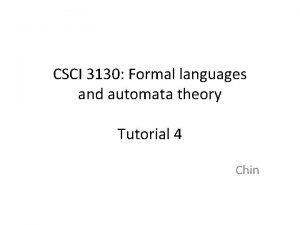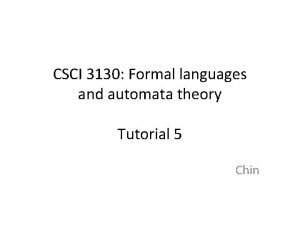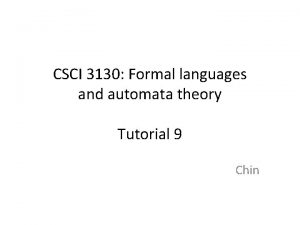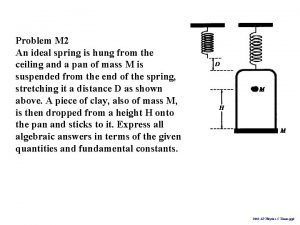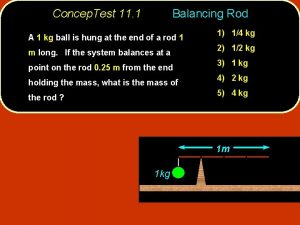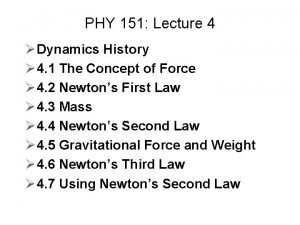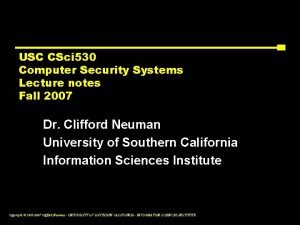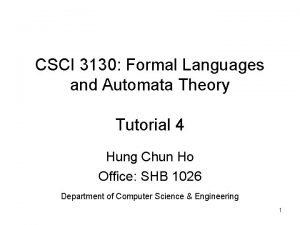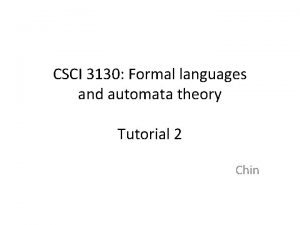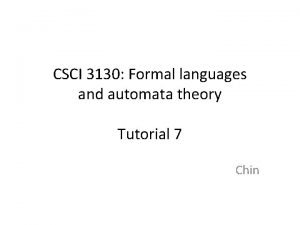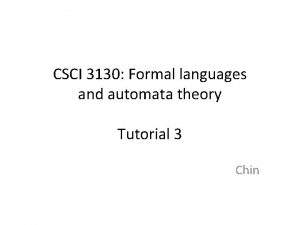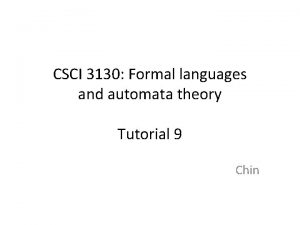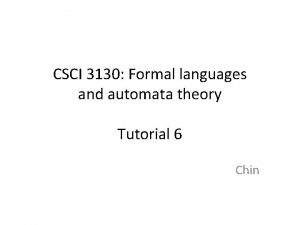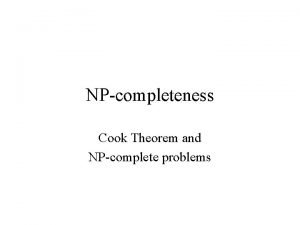NPcomplete examples CSCI 3130 Tutorial 10 ChunHo Hung
































![[Recap] Vertex cover �A vertex cover, C, is a set of vertices that covers [Recap] Vertex cover �A vertex cover, C, is a set of vertices that covers](https://slidetodoc.com/presentation_image/30d718852abc36345841871a8fecb1b8/image-33.jpg)






- Slides: 39

NP-complete examples CSCI 3130 Tutorial 10 Chun-Ho Hung chhung@cse. cuhk. edu. hk Department of Computer Science & Engineering 1

Outline �Review �P, NPC �Polynomial-time Reduction � 2 problems �Double-SAT �Dominating set � http: //en. wikipedia. org/wiki/Dominating_set_problem 2

Review P, NPC Polynomial-time Reduction 3

P �P is the class of all languages that have poly-time algorithm �e. g. , Shortest path on a directed graph, Sorting 4

NP �NP is the class of all languages that have poly-time verifier �A verifier – a Turing Machine, V, s. t. �Given a potential x �x ∈ L V accepts input <x, s> for some s � Solution s �V runs in polynomial time 5

NP (con’t) �While verifying a solution of a NP problem is easy (in poly-time), finding a solution could be more difficult �An 3 SAT instance - Find a satisfying assignment for f = (x 1∨x 2 ) ∧ (x 2 ∨x 3 ∨x 4) ∧ (x 1) �Verifying �Given an assignment, just evaluate the truth value �Finding a solution? �No efficient algorithm has been discovered yet 6

P versus NP �Every language, L in P, L is also in NP �Let Verifier = Poly-time TM that solves L �Therefore �P is contained in NP �Note: L in NP does not imply that efficient algorithm that decides L does not exist NP P 7

NPC �A language C is NP-complete if: �C is in NP �Every language L in NP, L poly-time reduces to C �What is a reduction…? 8

Reduction �The direction of the reduction is very important �Saying “A is easier than B” and “B is easier than A” mean different things �“A (polynomially) reduces to B” means “B is not easier than A” 9

Reduction (Con’t) �Consider 2 problems: 1) BFS on unweighted graph 2) Shortest path on weighted graph �Assume we have a TM, V, which solves 2) �We can reduce 1) to 2): �Given an instance of 1), convert it into an instance of 2): �Copy the graph, add weight=1 to every edge in 2) �Run this instance on V, output result �These two “yes” instances corresponds to each other 10

Poly-Time Reduction �How to show that a problem B is not easier than a problem A? �Informally, if B can be solved efficiently, we can solve A efficiently �Formally, we say A polynomially reduces to B if: 1. Given an instance a of problem, x 2. There is a polynomial time transformation to an instance of B, y = f(x) 3. x is a “yes” instance if and only if y is a “yes” instance 11

Poly-Time Reduction (Con’t) �Suppose A poly-time reduces to B �Then there exists a poly-time TM, R, s. t. , �Given an instance of A, x, transforms it to an instance of B, y = f(x), and �y is accepted x is accepted 12

Poly-Time Reduction (Implication) �Suppose A reduces to B �If B is polynomial time solvable, then A is polynomial time solvable �If A is not polynomial time solvable, then B is not polynomial time solvable �Contrapositive x R Poly-time TM y TM for L’ acc rej 13

Poly-Time Reduction (Implication) �Suppose A reduces to B �Solving B cannot be easier than solving A �Suppose A is “difficult” while B is “easy” �However, by this reduction, you find a “easy” way to solve A �Consequently, if A is NPC, then B must be NPC x R Poly-time TM y TM for L’ acc rej 14

Poly-Time Reduction - P versus NP �To show P = NP, one could try to show that a NPC problem, C, can be solved in polynomial time. Why? �Every problem in NP poly-time reduces to C �If C can be solved in poly-time, so does each problem in NP �Then NP = P!! �But this is not that easy and it is counter-intuitive (to most people) too 15

P versus NP (Again) �Most believe that P ≠ NP, because intuitively searching for a solution is more difficult than verifying a solution �What does P = NP imply? �Know how to verify a solution in poly-time Know how to find a solution in poly-time (? !) �Indeed we prefer P ≠ NP � Encryption ≠ NP algorithms heavily rely on the assumption that P �P = NP or P ≠ NP is still an open problem 16

Relations NP-C hard Is there any problem even harder than NP-C? NP P Yes! e. g. I-go easy 17

Methodology �To show L is in NP, you can either (i) Show that solutions for L can be verified in polynomial-time, or (ii) Describe a nondeterministic polynomial-time TM for L (Come back to this if we have enough time) �To show L is NP-complete � Show that L is in NP � Poly-time reduce some NPC problem to L � i. e. , design a polynomial-time reduction from some problem we know to be NPcomplete 18

Example Proving a problem being NPC 19

Double-SAT �Problem: �Double-SAT = {<φ> | φ is a Boolean formula with at least two satisfying assignments} �Goal: �Show that Double-SAT is NP-Complete 20

Double-SAT (Proof Sketch) �Steps: 1) Show that Double-SAT ∈ NP 2) Show that Double-SAT is not easier than a certain NPC problem � For the NPC problem, we choose SAT � i. e. , we want to poly-time reduce Double-SAT to SAT 3) Show the correspondence of “yes” instance between reduction 21

Double-SAT - (1) NP �It is trivial to see that Double-SAT ∈ NP �Given 2 assignments for φ, and verify whether both of them satisfy φ �We can just evaluate the truth value in poly-time 22

Double-SAT - (2) Reduction �Reduction: �On input φ(x 1, . . . , xn): 1. Introduce a new variable w 2. Output formula φ’(x 1, . . . , xn, y) = φ(x 1, . . . , xn) ∧ ( w ∨ w ). x R x∈L SAT y y ∈ L’ Double-SAT TM for L’ acc rej TM accepts 23

Double-SAT - (3) Correspondence �x ∈ L y ∈ L’ � : Suppose there is an satisfying assignment, X, for φ(x 1, . . . , xn), we can find two satisfying assignments for φ’(x 1, . . . , xn, w): �Assignment 1 = {X, w=True} �Assignment 2 = {X, w=False} � φ’(x 1, . . . , xn, w) = φ(x 1, . . . , xn) ∧ ( w ∨ w ) For {xi}, assign X, then this part = True No matter what w is, this part = True 24

Double-SAT - (3) Correspondence �x ∈ L y ∈ L’ � : We use contrapositive �i. e. , to show x ∉ L ⇒ y ∉ L’ �Indeed, if x ∉ L, φ(x 1, . . . , xn)=False �Then, no matter what the value of y is �φ’(x 1, . . . , xn, y)=False 25

Dominating Set �Problem: �Dominating-set = {<G, K> | A dominating set of size K for G exists} �Goal: �Show that Dominating-set is NP-Complete 26

Dominating Set (Definition) �Problem: �Dominating-set = {<G, K> | A dominating set of size (at most) K for G exists} �Let G=(V, E) be an undirected graph �A dominating set D is a set of vertices that covers all vertices �i. e. , every vertex of G is either in D or is adjacent to at least one vertex from D 27

Dominating Set (Example) �Size-2 example : {Yellow vertices} e 28

Dominating Set (Proof Sketch) �Steps: 1) Show that Dominating-set ∈ NP. 2) Show that Dominating-set is not easier than a NPC problem � We choose this NPC problem to be Vertex cover � Reduction from Vertex-cover to Dominating-set 3) Show the correspondence of “yes” instances between the reduction 29

Dominating Set - (1) NP �It is trivial to see that Dominating-set ∈ NP �Given a vertex set D of size K, we check whether (V-D) are adjacent to D �i. e. , for each vertex, v, in (V-D), whether v is adjacent to some vertex u in D 30

Dominating Set - (2) Reduction �Reduction - Graph transformation � Construct a new graph G' by adding new vertices and edges to the graph G as follows: G <G, k> ∈ L Vertex-cover T G’ <G’, k> ∈ L’ Dominating-set 31

Dominating Set - (2) Reduction �Reduction - Graph transformation (Con’t) � For each edge (v, w) of G, add a vertex vw and the edges (v, vw) and (w, vw) to G' � Furthermore, remove all vertices with no incident edges; such vertices would always have to go in a dominating set but are not needed in a vertex cover of G � We skip the discussion of this subtle part in the followings G <G, k> ∈ L Vertex-cover T G’ <G’, k> ∈ L’ Dominating-set 32
![Recap Vertex cover A vertex cover C is a set of vertices that covers [Recap] Vertex cover �A vertex cover, C, is a set of vertices that covers](https://slidetodoc.com/presentation_image/30d718852abc36345841871a8fecb1b8/image-33.jpg)
[Recap] Vertex cover �A vertex cover, C, is a set of vertices that covers all edges �i. e. , each edge is at least adjacent to some node in C 1 2 3 4 {2, 4}, {3, 4}, {1, 2, 3} are vertex covers 33

Dominating Set – Graph Transformation Example v w vw v w vz wu vu z u G z u zu G' 34

Dominating Set - (3) Correspondence �A dominating set of size K in G’ A vertex cover of size K in G � Let D be a dominating set of size K in G’ � Case 1): D contains only vertices from G Then, all new vertices have an edge to a vertex in D D covers all edges D is a valid vertex cover of G 35

Dominating Set - (3) Correspondence �A dominating set of size K in G’ A vertex cover of size K in G � Let D be a dominating set of size K in G’ � Case 2): D contains some new vertices (vertex in the form of uv) (We show to construct a vertex cover using only old vertices, otherwise we cannot obtain a vertex cover for G) For each new vertex uv, replace it by u (or v) If u ∈ D, this node is not needed Then the edge u-v in G will be covered After new edges are removed, it is a valid vertex cover of G (of size at most K) 36

Dominating Set - (3) Correspondence �A dominating set of size K in G’ A vertex cover of size K in G � Let C be a vertex cover of size K in G For an old vertex, v ∈ G’ : � By the definition of VC, all edges incident to v are covered � v is also covered For a new vertex, uv ∈ G’ : � Edge u-v must be covered, either u or v ∈ C � This node will cover uv in G’ Thus, C is a valid dominating for G’ (of size at most K) 37

Dominating Set - (3) Correspondence vw v w vz wu vu z u Vertex-cover in G z u zu Dominating-set in G' 38

End Any questions? (There should be some) 39
 Csci 3130
Csci 3130 Formal languages and automata theory tutorial
Formal languages and automata theory tutorial Csci3130
Csci3130 Cyk algorithm
Cyk algorithm Csci 3130
Csci 3130 Allcfg
Allcfg Heather lipford
Heather lipford Ece 3130
Ece 3130 Ece 3130
Ece 3130 Ece 3130
Ece 3130 Cisc 3130
Cisc 3130 Dawn dude rugs
Dawn dude rugs A spring is hung from the ceiling
A spring is hung from the ceiling Whats a hung jury
Whats a hung jury Dr hung nguyen
Dr hung nguyen Hung fan sing
Hung fan sing Hungyi lee
Hungyi lee Samantha hung
Samantha hung Hungyi
Hungyi Vua hùng một sáng đi săn
Vua hùng một sáng đi săn Anh hùng lấy thân làm giá súng
Anh hùng lấy thân làm giá súng Hungyi
Hungyi Yvonne hung
Yvonne hung Tranh đền hùng
Tranh đền hùng Substantv
Substantv Ernest hung
Ernest hung Abdominal reflex pathway
Abdominal reflex pathway Vua hùng
Vua hùng Hung up tree
Hung up tree Cao đẳng nghề trần hưng đạo
Cao đẳng nghề trần hưng đạo A loose spiral spring is hung from the ceiling
A loose spiral spring is hung from the ceiling Phùng hưng
Phùng hưng Thpt mỹ hòa hưng an giang
Thpt mỹ hòa hưng an giang Newton law 3
Newton law 3 Hãy kể những điều em biết về các vua hùng
Hãy kể những điều em biết về các vua hùng Hung bui
Hung bui Hung yi lee
Hung yi lee Csci 4211
Csci 4211 Csci 530
Csci 530 Csci 530
Csci 530



